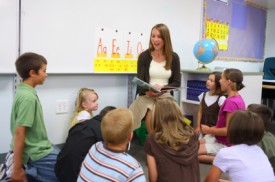
Ever since the letter K was a baby, she loved to make her signature sound: ka, ka, ka. K knew that the only other letters in the alphabet that could make her “ka” sound were the letter C (when he didn’t sound like an S) and the letter Q. K enjoyed making her “ka” sound as often as possible in as many words as she could. Soon, however, K also learned that whenever she stood in front of the letter N at the beginning of a word, it was impossible to make her signature sound. At first, K was very sad about this, but after working with N and other letters to make fun words like knot, knob, kneel, and know—words that the other letters could only make with her help—K learned that staying silent sometimes was an important job for a letter, and that many of her alphabet friends also had to be silent from time to time. After a while, K was just as comfortable being silent as she was making her signature “ka” sound.
Scientists have long known that human beings are storytelling creatures. For centuries, we have told stories to transmit information, share histories, and teach important lessons. While stories often have a profound effect on us due to emotional content, recent research also shows that our brains are actually hard-wired to seek out a coherent narrative structure in the stories we hear and tell. This structure helps us absorb the information in a story, and connect it with our own experiences in the world.
Educators can create memorable learning experiences for their students by harnessing the power of storytelling in the classroom. A 2010 study in the Proceedings of the National Academy of Sciences showed an intimate connection between the brain activity of speakers and listeners in conversation, demonstrating how the brain of an engaged listener “syncs up” with a speaker. By engaging students with compelling stories that impart important material, teachers reach students both emotionally and biochemically, increasing the potential for rich learning experiences.
Creating a compelling story with a coherent narrative structure requires attention to detail, descriptive language, and a beginning, middle, and end of some sort. Different kinds of stories produce different kinds of reactions: personal stories from the teacher’s own experience can help create and solidify strong bonds between educator and student, while stories of pure fiction may stimulate imagination.
Spending a little extra time on storytelling during lesson planning and actual classroom time keeps the learning experience highly engaging, creative, and truly, dynamically human. A story-filled classroom also encourages students to relate their own stories (whether factual or fictional), which helps grow their critical thinking, memory, and vocabulary skills.
Further reading:
Melanie C. Green. Storytelling in teaching. Association for Psychological Science. April 2004.
Related Reading:
5 Reasons Why Your Students Should Write Every Day
The Question Formulation Technique: 6 Steps to Help Students Ask Better Questions

